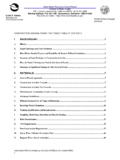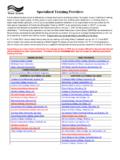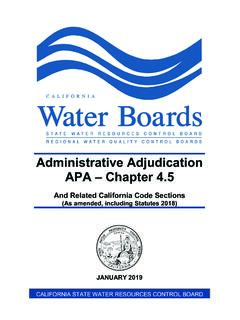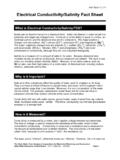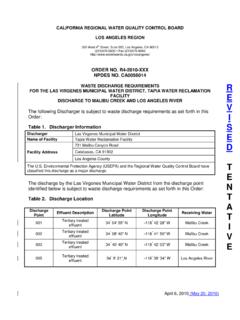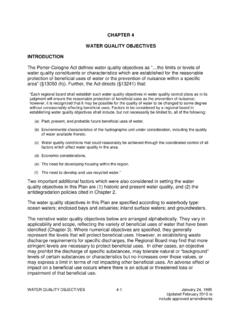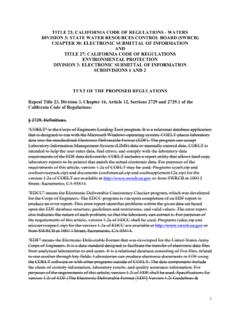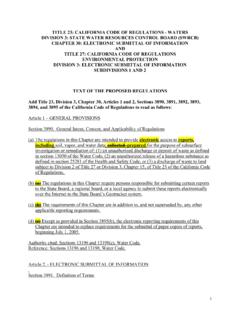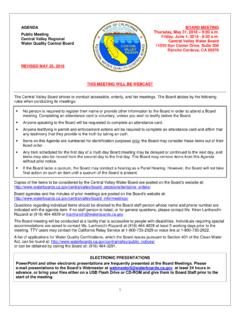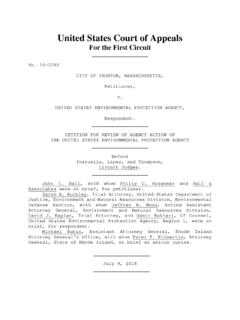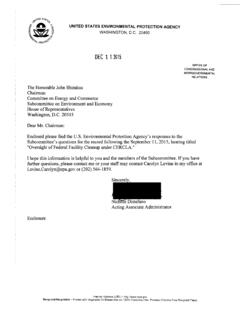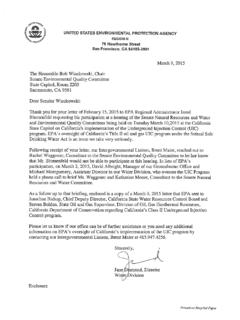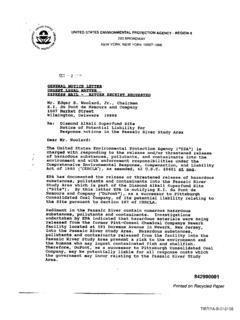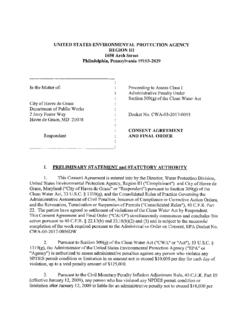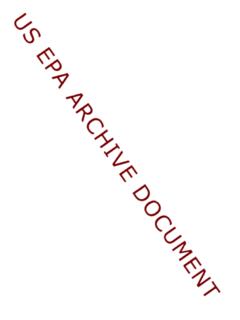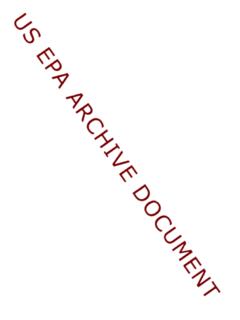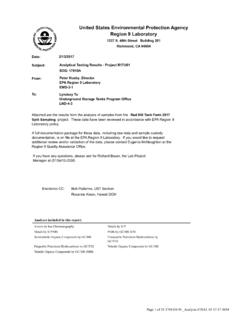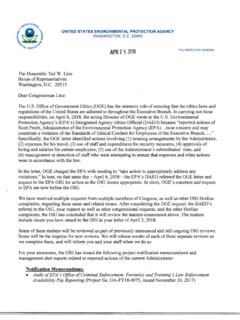Transcription of UNITED STATES ENVIRONMENTAL PROTECTION …
1 UNITED STATES ENVIRONMENTAL PROTECTION AGENCY REGION IX 75 Hawthorne Street San Francisco, CA 94105-3901 OCT 3 0 2017 Jeff Geraci Sr. ENVIRONMENTAL Scientist California Regional Water Quality Control Board Colorado River Basin Region Board Room 73-720 Fred Waring Drive, Suite 100 Palm Desert, CA 92260 Dear Mr. Geraci: RECEIVED NOV - 3 2017 REGION7 This letter responds to the Regional Board' s solicitation of public comments for recommendations or revisions to the Final Draft 2017 Triennial Review List for the Colorado River Basin Water Quality Control Plan (Basin Plan). The ENVIRONMENTAL PROTECTION Agency (EPA) appreciates the opportunity to provide input to the Triennial Review process with the following comments: We agree that the projects summarized in the Final Draft 2017 Triennial Review are priority issues. Additionally, we continue to support as a high priority, identification of freshwaters that support early life stages of salmonids, and revision of pentachlorophenol (PCP) water quality objectives, where appropriate, as part of this Triennial Review process.
2 This request is a result of EPA's Endangered Species Act consultation with the Fish and Wildlife Service and National Marine Fisheries Service (the Services) for the California Toxics Rule (CTR). The Services' Biological Opinion for the CTR concluded that the CTR criteria for PCP were not protective of early life stages of salmonids under conditions of low dissolved oxygen and high temperatures. Protective criteria are outlined in US EPA's November 14, 2007 letter to the State and Regional Boards (see enclosure). To comply with 40 CFR Section , the Triennial Review must include an explanation if the State does not adopt new or revised criteria for parameters for which EPA has published new or updated Clean Water Act (CWA) section 304(a) criteria recommendations. Tables containing the most recent 304(a) criteria recommendations can be found at the following websites: and Printed on R ecycled Paper Thank you for the opportunity to comment on the 2017 Triennial Review.
3 If you have any questions, please contact me at (415) 972-3508 or Sincerely, Matthew Mitchell Water Quality Assessment Section Enclosure ' ., UNITED STATES ENVIRONMENTAL PROTECTION AGENCY REGION IX 75 Hawthome Street San Francisco, CA 94105-3801 NOV 14 ~ Rik L. Rasmussen Chief, Planning Standards and Implementation Unit State Water Resources Control Board Box 100 Sacramento, CA 95812 Re: Pentac~orophenol (PCP) Criteria Dear Mr. Rasmussen: RECEIVED NUV - 3 2017 REGION7 Please find enclosed, a letter from Edward Ohanian, Director of Health and Ecological Criteria Division, Office of Water, dated August 24, 2007, to the US Fish and Wildlife (FWS) and the National Marine Fisheries Service (NMFS) (the Services) Offices for the California area. This letter concerns follow up actions stemming from the Endangered Species Act consultation on the California Toxics Rule (CTR), for pentachlorophenol (PCP). The Services' Biological Opinion for the CTR concluded that the CTR's PCP water quality criteria for the PROTECTION of aquatic life were not protective of early life stages of salmonid fish under conditions of low dissolved oxygen (DO) and high temperatures.
4 EPA accepted the premise offered by the Services that more restrictive PCP criteria may be necessary to protect early life stage salmonid fish in California, and detennined what those criteria values should be. However, EPA believes it is appropriate for the State to determine where those specific situations might occur, and to take appropriate action to protect those species at the relevant locations. Hence, we are writing to you, to request your and the Regional Boards' assistance in identifying where these areas occur and to adopt the appropriate PCP water quality criteria, during the next triennial review of each Regional Board Basin Plan. Specifically, EPA is now recommending that in California, the weight of evidence supports the applicability of the current (CTR) PCP criteria on a statewide basis with site-specific adjustments when necessary to protect particularly sensitive. species or address unusual water quality parameters. EPA recommends that the State, on a site-specific basis, adopt an aquatic life chronic value of IO ug/1 to protect early life-stage salmonids from the toxic effects of PCP at a pH , and an aquatic life chronic value of 5 ug/1 to adequately protect these life stages under conditions of low dissolved oxygen and high temperature.
5 The scientific justification for our recommendation is attached to the enclosed letter. We recommend that each Regional Board consider where these conditions may occur and consider adopting appropriate site-specific objectives accordingly, in their Basin Plans. Printed on Rrcycled P~r We thank you for your attention to this issue. If you have any questions concerning the jtistificatioh, please contact William Swietlik of Mr. Ghanian's staff at (202) 566-1129 or for, questions concerning implementation, please contact me or Diane Fleck at 415 972-3420 and 415 972-3480, respectively. Douglas E. Eberhardt, Chief Clean Water Act Standards and Permits Office Enclosure cc: Holly Lundborg, North Coast RWQCB Naomi Feger, San Francisco ~WQBC Lisa Horowitz Mccann, Central Coast RWQCB Sam Unger,. Los Angeles RWQCB Betty Yee, Central Valley RWQCB .Judith Unsicker, Lahonton RWQCB Cliff& ey, Colorado River Basin RWQCB Mark Adelson, Santa Ana RWQCB Julie Chan, San Diegi;> RWQCB Daniel Russell, US Fish and Wildlife Thomas Maurer, US Fish @lld Wildlife Joseph Dillon, National Marine Fisheries Service UNITED STATES ENVIRONMENT AL PROTECTION AGENCY WASHINGTON, 20460 Mr.
6 Steve Thompson Manager AUG 2 4 2007 California/Nevada Operations Office Department of the Interior Fish and Wildlife Service 2800 Cottage Way, Room W-2606 Sacramento, CA 95825-1846 Mr. Rodney R. Mclnnis Regioilal Administrator Southwest Region National Marine Fisheries Service 501 West Ocean Boulevard, Suite 4200 Long Beach, CA 90802-4213 . Dear Mr. Thompson and Mr. Mcinnis: I OFFICE OF WATER On August 3, 2004, I sent a letter to the Services responding to Reasonable and Prudent Measmes (RPMs) in the Incidental Take Statement for pentachlorophenol (PCP) in the California Toxics Rule (CTR). In response to my letter, I received a letter from each of the Services (Mr. Mclnnis's letter-dated November 18, 2004, and Mr. Henson's letter - dated November 22, 2004) expressing concerns with our decision on the PCP criteria and requesting additional information and clarification. The additional information requested, including all materials us by Dr. Chapman, Dr. Waitering, and Dr.
7 Erickson that were utilized in making our decision on PCP criteria, was then forwarded to your offices. In addition, the ENVIRONMENTAL PROTECTION Agency and Fish and Wildlife Service (FWS) staff met in a face-to-face meeting in San Francisco, CA, in April 2005 to further discuss the PCP criteria with the objective of identifying and resolving all lingering issues and questions. At this meeting FWS staff clarified their concerns and identified even more information they needed to better understand our decision. This information was provided to your staff shortly thereafter. Internet Addres1 (UR~) Racycled/Racycl1bl, Printed with Vegetable OIi Based Inks on 100% Poslcoosumer, Process Chlorine Free Recycled Peper .. Your staff also requested we develop a more comprehensive justification for our PCP decision beyond that stated in the original August 3, 2004, letter. If we did this, your staff indicated they would be in a better position to agree with our decision.
8 I am enclosing the final additionaUustification for our PCP decision. We believe we have now answered all lingering questions and provided all requested information, . and as such, now meet the terms and conditions under the Biological Opinion for PCP. If you have any questions about the enclosure, please contact William Swietlik of my staff at (202) 566-1129, or e-mail at Sincerely, 'J:.-1-, ~ \ Edward V. Ohanian, Director ~ Health and Ecological Criteria Division Enclosure I I I EPA JUSTIFICATION OF SITE-SPECIFIC AND STATE-SPECIFIC PCP CRITERIA FOR CALIFORNIA Background On August 5, 1997, EPA proposed freshwater acute and chronic criteria for pentachlorphenol (PCP) for the PROTECTION of aquatic life in California's waters as a part of the California Toxics Rule (CTR). At that time, EPA made the detennination that the national ambient water quality criteria for PCP were adequately protective of species in California waters. The current Clean Water Act (CWA) 304(a) acute and chronic freshwater PCP criteria promulgated by EPA for California under the CTR are 19 and 15.
9 G/L at pH respectively., As a part of the Endangered Species Act (ESA) consultation on the CTR, the Fish and Wildlife Service and the National Marine Fisheries Service (collectively the Services)jointly prepared a Biological Opinion (BO) which reviewed the PCP criteria proposed in the CTR. The BO concluded that the proposed PCP criteria for the PROTECTION of aquatic life in California waters were not protective of early life-stage salmonid fish under conditions of low dissolved oxygen (DO) and high temperature. For example, the BO concluded that at pH , acute and chronic freshwater PCP criteria g/L and g/L, respectively, would be necessary to provide PROTECTION for early life-stage salmonids under conditions of low DO and high temperature. Since the time of that -conclusion, and following a series of activities to resolve jeopardy concerns for the CTR per agreement with the Services (see March 24, 2000 BO in the Reasonable and Prudent Measures for the Inciqental Talce Statement for PCP), EPA summarily accepted the premise 9ffered by the Services that early life-stage salmonid fish in California are more sensitive than other fish, and that more restrictive PCP criteria may be necessary to protect these species in California waters.
10 In acknowledging as much, however, EPA also believes that it is appropriate for the state to determine where those specific situations might occur, and to talce the appropriate action to protect those species at the relevant locations. This EPA position was recently communicated to Mr. Paul Henson (Assistant Manager for Ecological Services, Fish and Wildlife Service, California/Nevada Operations Office) and Mr. Tim Price (Acting Assistant Regional Administrator, NOAA Fisheries Southwest Region) in a letter from Mr. Edward Ohanian, Director of EPA's Health and Ecological Criteria Division) dated (August, 3, 2004). In brief, EPA's reassessment of the PCP criteria found that the weight of evidence supports the applicability of the current criteria on a national basis with site-specific and state-specific adjustments when necessary to protect particularly sensitive species or address unusual water quality parameters. Given our re-evaluation of this original decision, since then, EPA maintains that the current CWA 304(a) criteria for PCP will protect against acute and chronic toxicity of commercial grade PCP under normal conditions found in most parts of California and the rest of the country.
